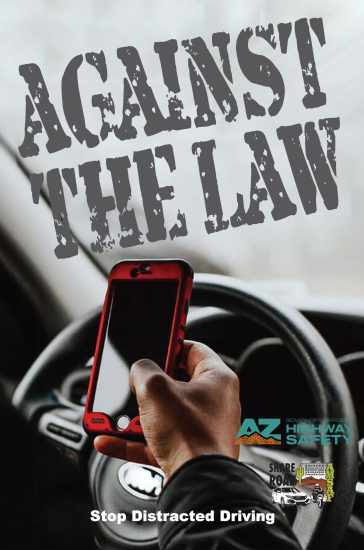Road Safety Laws
Laws of the Road
Distracted Driving
Did you know…
- It is illegal in Arizona to talk or text on a cell phone while driving unless the phone is used in hands-free mode
- Since January 2021, the law prohibits making or answering a call
- It is against the law while driving to make or answer a call unless your device or cellphone is being used in hands-free mode
- Sending or reading text messages or viewing “internet data” while driving is against the law
- It is against the law while driving to read, write, or send a message via any portable wireless communication device, scroll through social media, watch or record videos, take photos, or use any of the devices that cause a distraction and require the use of your body
- Holding or supporting a device with your body
- While driving, it is against the law to physically hold or support a phone with any part of your body (this includes, but is not limited to, holding your device in your hands or perched on your shoulder)
- This law also applies to “stand-alone electronic devices,” which are portable devices that store data files such as computers, pads, MP3 players, etc.
- A driver may use hands to activate or deactivate a hands-free communication device such as GPS for navigation of the vehicle, answer or end a hands-free call, or make an emergency 911 call

Know the law. Tell your friends. Save a life.
Together, we can make a difference.

Arizona Lane Filtering
Here are the rules and guidelines explained for lane filtering in Arizona.
In Arizona, lane filtering is a relatively new law that allows motorcyclists to navigate through traffic in specific situations. Lane filtering, distinct from lane splitting, permits motorcyclists to move between stopped vehicles at intersections under controlled conditions. This law aims to enhance the safety and efficiency of motorcycle travel, particularly in congested areas.
According to Arizona law, motorcyclists can engage in lane filtering only when traffic is stopped. The maneuver must be executed at a speed not exceeding 15 miles per hour, and it is limited to roads with a speed limit of 45 miles per hour or less. These restrictions are designed to minimize the risk of accidents, ensuring that motorcyclists can safely navigate through traffic without causing disruptions or endangering themselves and others.
The implementation of lane filtering laws in Arizona is intended to reduce rear-end collisions, one of the most common types of accidents involving motorcycles. By allowing motorcyclists to move to the front of traffic queues, the law helps prevent situations where motorcycles are vulnerable to being struck from behind by inattentive drivers. Additionally, lane filtering can alleviate traffic congestion by utilizing the road space more efficiently.
It is crucial for both motorcyclists and drivers to be aware of and understand the lane filtering law to ensure safe and harmonious road sharing. Motorcyclists should practice lane filtering responsibly, adhering to the speed and situational limitations. Drivers, on the other hand, should remain vigilant and allow motorcyclists the space to maneuver as permitted by law. By respecting these guidelines, all road users can contribute to a safer and more efficient traffic environment in Arizona.




